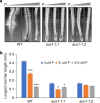Rice auxin influx carrier OsAUX1 facilitates root hair elongation in response to low external phosphate
- PMID: 29650967
- PMCID: PMC5897452
- DOI: 10.1038/s41467-018-03850-4
Rice auxin influx carrier OsAUX1 facilitates root hair elongation in response to low external phosphate
Erratum in
-
Author Correction: Rice auxin influx carrier OsAUX1 facilitates root hair elongation in response to low external phosphate.Nat Commun. 2018 May 1;9(1):1810. doi: 10.1038/s41467-018-04280-y. Nat Commun. 2018. PMID: 29717128 Free PMC article.
Abstract
Root traits such as root angle and hair length influence resource acquisition particularly for immobile nutrients like phosphorus (P). Here, we attempted to modify root angle in rice by disrupting the OsAUX1 auxin influx transporter gene in an effort to improve rice P acquisition efficiency. We show by X-ray microCT imaging that root angle is altered in the osaux1 mutant, causing preferential foraging in the top soil where P normally accumulates, yet surprisingly, P acquisition efficiency does not improve. Through closer investigation, we reveal that OsAUX1 also promotes root hair elongation in response to P limitation. Reporter studies reveal that auxin response increases in the root hair zone in low P environments. We demonstrate that OsAUX1 functions to mobilize auxin from the root apex to the differentiation zone where this signal promotes hair elongation when roots encounter low external P. We conclude that auxin and OsAUX1 play key roles in promoting root foraging for P in rice.
Conflict of interest statement
The authors declare no competing interests.
Figures





Comment in
-
Low Phosphate Puts Auxin in the Root Hairs.Trends Plant Sci. 2018 Oct;23(10):845-847. doi: 10.1016/j.tplants.2018.07.009. Epub 2018 Aug 7. Trends Plant Sci. 2018. PMID: 30097376
References
-
- Lynch JP, Brown KM. Topsoil foraging – an architectural adaptation of plants to low phosphorus availability. Plant Soil. 2001;237:225–237. doi: 10.1023/A:1013324727040. - DOI
Publication types
MeSH terms
Substances
LinkOut - more resources
Full Text Sources
Other Literature Sources
Miscellaneous

